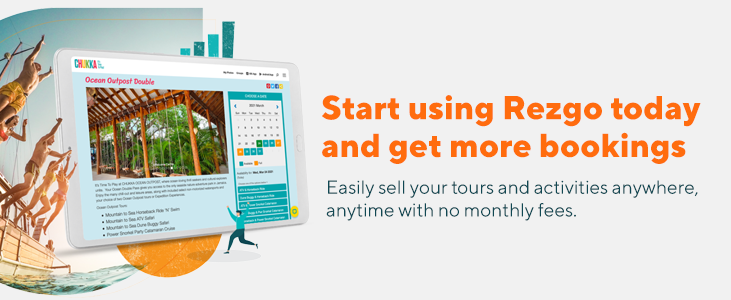When online bookings are a big part of your business, it’s easy to get caught up in the idea that you need to reach far and wide to find success. But it’s always worth developing local sources of business, whether your core customer base is international travelers or regulars from your neighborhood.
According to travel technology company iSeatz, Inc., nearly 60 percent of activities are booked in-destination, with most being booked the day of the activity (so it helps to support last-minute bookings). If you’re not marketing locally, you’re missing out on a huge group of travelers, staycationers and local adventurers who are eager to book.
So how do you reach the customers who are already in your own back yard?
Local search
When we’re looking for a fun way to spend a day, the first thing most of us do is pull out our phones. Google has tracked up to a 900% increase in mobile searches that include the phrase “near me” over the past few years, with particularly high spikes for people looking to buy and people who want to find something available right now.
It’s imperative that your business shows up in local search. If you have a booking website, you’re already partway there—when Google’s algorithms work their magic, a well-optimized website will contribute to your ranking. But if you want to be sure that customers will find you when they want to book something nearby, you also need to make sure you’re listed in local search resources—particularly Google My Business.
Companies like Google are increasingly relying on these business profiles to drive local search results. Since consumers are turning local search into a daily habit, you don’t want to let these free hits slip away.
Local ads
Online ads can be an expensive prospect, but if you know exactly who you want to reach, you can keep to a reasonable advertising budget.
Advertising platforms like Google Ads and Facebook Ads work best when you are trying to reach specific groups. Constraining your ads to specific locations and user demographics doesn’t just save you money—it also makes your campaigns much more effective.
Start by looking at the customers you currently have. Where are they from? What are their demographics? What are they getting out of your products?
Target a campaign at locals who can book on a whim with compelling reasons to do just that, and you can stretch your advertising a lot further.
Local distributors
Activity desks and visitor information centers (VIC) are a big source of local bookings for many tour and activity companies. The majority of visitors to information centers are there looking for things to see and do, so you can be certain that your efforts are reaching the right audience.
And despite the name, people aren’t just looking for information. According to Tourism Research Australia, 14 percent of the people who came to a visitor information center ended up making a booking during their visit. Busy centers can see millions of annual visits, so that’s quite a lot of bookings.
Getting your tours and activities into relevant VICs can be a complicated process, so check out our guide if you need help getting started.
While you’re building relationships with local distributors, don’t forget about hotel concierges. Concierges have a reputation for local expertise to maintain, so working with them is a great way to reach travelers who want a truly local experience.
Rezgo offers a full suite of tools to support working with concierges and other local distributors, including commission price sheets, referral tracking, comprehensive reports, and more. With all that, you’re ready to start cultivating relationships with concierges.
Local influencers
Social media influencers aren’t just huge, international celebrities with millions of followers. Micro-influencers, who might only have a few thousand followers online, tend to have more engaged audiences than the big names. Depending on their focus, this can make them perfect for your local marketing efforts.
If you already have a successful Instagram account, you might not even need to look far. The Startup recommends finding micro-influencers who already follow you, or who’ve done business with you, as a natural starting point for local marketing. Otherwise, dig into local hashtags and see who’s getting attention and whose brand works well with yours. Getting your tours and activities into their photos and stories can be a great way to drum up interest from engaged locals.
Don’t be afraid to look at local bloggers, too. While Instagram dominates the influencer conversation, it’s not the right platform for every demographic. To succeed at local marketing, you need to be wherever your ideal customers can be found.
Local customers
While you’re doing all you can to reach new customers in your neighborhood, don’t forget the old ones. Your guests are one of the most effective resources in your marketing toolbox.
Local guests are particularly good targets for personalized campaigns. Give them the tools they need to spread positive word of mouth: links to leave reviews on your website and local search profiles, promos to share with friends and family, referral programs and loyalty programs to keep them coming back for more.
By making good use of the customer data you already have, you can increase local bookings without breaking the budget.
No matter where your bookings come from, be it close to home or around the globe, your online booking platform can help. Rezgo makes it simple to work with local distributors, to track important customer data, and most importantly, to get bookings from customers wherever they might be, near or far.
Learn more about our booking software options for destination marketing organizations (DMOs).







